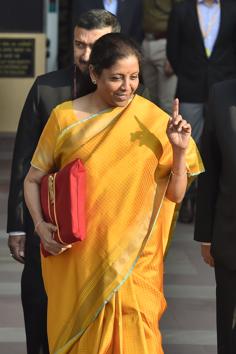What the Union Budget did not say | Opinion
The focus should have been on rejuvenating the informal economy, not the vision of formalisation
The 2020-21 Union Budget is on expected lines, as far as key parameters are concerned. Fiscal deficit as a percentage of GDP has gone up by 50 basis points (one basis point is 100th of a percentage point) to 3.8% in 2019-20. The government has missed both its receipt and expenditure targets in the current fiscal year. This was expected in the wake of the lowest nominal GDP growth in more than four decades. The fiscal deficit for next year would have been much bigger had the government not decided to proceed with strategic divestment of the Life Insurance Corporation, which, if implemented, will be the biggest in the country’s history. That the government has taken such a drastic step underlines its commitment to fiscal consolidation.

The budget also projects a conservative growth outlook for the next fiscal year. A 10% nominal growth rate projected for 2020-21 is the lowest since 2008-09. This is in keeping with the Economic Survey’s projection of real growth being in the range of 6%-6.5% and no drastic increase in inflation. It reiterates this government’s achievements on maintaining low inflation and unleashing structural reforms such as the roll-out of the Goods and Services Tax (GST) and the Bankruptcy Code. There is further movement in the government’s commitment towards simplifying the direct tax regime, as can be seen in the floating of an alternative no exemption, low income tax regime, without doing away with the existing regime.
Also Watch | HT’s top editors decode Modi government’s Budget 2020-21
So what is remarkable about this year’s budget? The answer has to be found in what the budget does not say or do, rather than what it has done. Here’s why.
Any budget is an exercise in balancing government expenditure against receipts. The bulk of government receipts are revenue receipts, which are a function of income generation and, therefore, GDP growth. So, if GDP growth goes down, most calculations in the budget fall flat. This is what has happened in the current fiscal year, as nominal GDP growth ended up being 7.8%, against the last budget’s projection of 12%.
The Economic Survey would like us to believe that the slowdown in growth is driven by international and cyclical factors. There is good reason to believe that this is not true.
The latest data released by the National Statistical Office (NSO) on Friday evening shows that the Indian economy has been losing momentum since 2016-17. GDP growth, which climbed to 8.3% in 2016-17, has been falling continuously since then. It was 7% in 2017-18, 6.1% in 2018-19 and 5.7% in 2019-20. The Indian economy was subjected to back-to-back shocks of demonetisation and GST between November 2016 and July 2017. The pains of these policies, which the government now says were meant to push formalisation in the economy, were borne disproportionately by the informal sector, which is where the bulk of the Indian workforce is employed. While some part of this pain was supposed to be transient, especially after liquidity was restored post-demonetisation, a significant part of it could have been structural especially vis-à-vis GST-related costs.
Many economists had warned that these shocks to the informal sector could adversely affect income generation and, therefore, GDP growth. This was backed by government’s own statistics. Surveys conducted by the NSO show that unemployment rate jumped to a four-decade high in 2017-18 and inflation adjusted consumption actually went down between 2011-12 and 2017-18. The government’s response was to ignore the warning and dismiss the employment numbers as not comparable. It has also junked the consumption survey.
These numbers make for bad headlines. But economic policy works in a continuum. If the government of the day does not accept existing economic realities, its policies, and the assumptions on the basis of which they are formed, are unlikely to be effective.
This is why last year’s budget ended up overestimating growth and revenues in a big way. This is also why, the government has ended up spending significantly more (Rs 71,000 crore against Rs 60,000 crore) under the Mahatma Gandhi National Rural Employment Guarantee Scheme (MGNREGS) this year. It needs to be understood that MGNREGS pays less than market wages and is often plagued with payment delays. It is only the most desperate who seek work under the scheme.
Contrary to popular perception, a distress-ridden rural and informal sector in an economy like India has the potential of triggering a contagion in the formal economy as well. The poorest, after all, spend a much larger part of their incomes than the rich. Any squeeze in their purchasing power implies a big hit to aggregate demand. It is entirely likely that the slowdown in the formal sectors of the economy is a lagged effect of the hit in the informal sectors.
This is where this government’s macro-economic vision is misplaced. It believes that it can revive aggregate demand by boosting the incomes of the relatively rich — the segment which stands to benefit from direct tax concessions. It also believes that technological plumbing such as direct benefit transfer is a substitute to an aggressive budgetary rural stimulus. It is not. The government could not spend 28% of the Rs 75,000 crore earmarked for PM-KISAN in 2019-20, most probably due to Aadhaar-related seeding problems.
Unless the dominant economic vision of formalisation is replaced by rejuvenation of the informal economy, this government’s assertions of macroeconomic stability may not be convincing.






